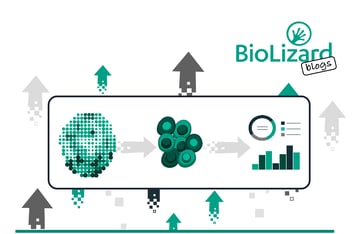Trends in single cell sequencing: High-throughput technologies
The value of single cell sequencing is now cemented in the annals of the life science industry – and as a result, new methods and technologies are emerging that allow scientists to sequence more and more cells at a lower and lower cost. The ability to multiplex millions of cells at a reduced cost means that we can now sequence a sufficient number of individual cells per sample and condition. In other words, thanks to these advanced, high-throughput single cell sequencing technologies, it’s now possible to sequence many different samples in parallel at unprecedented resolution - providing new opportunities to test different conditions simultaneously, achieve more robust results, and drive the discovery of improved therapeutics and diagnostics.
Now, without further ado, let’s get into the details of high-throughput single cell sequencing – and when it makes sense to use it!
Applications of high-throughput single cell sequencing
High-throughput single cell sequencing has great potential and value across the whole drug discovery pipeline, and these technological advancements mean that you can now scale your experiments to make them more time-efficient and cost-effective. For instance, if you aim to undertake a large-scale screening, you can now multiplex your data, sequencing hundreds of conditions or screening hundreds of compounds in parallel. This new possibility for large-scale, multiplexed single cell screens will also be beneficial for researchers interested in drug repurposing.
In addition, high-throughput single cell sequencing opens new avenues into modern diagnostics. The possibility of rapid and cost-effective sequencing of many different patient samples means that it will become increasingly possible to stratify patients to a very individual level based on sequencing data, enabling the identification of specific disease signatures and individual responses to treatments. In the future, this could provide new grounds for highly personalised treatments and enhanced diagnostics.
Finally, we also foresee that the advances in high-throughput single cell sequencing will make it easier for scientists to extract more information out of highly valuable and limited specimens, such as rare patient samples. If you are studying a rare disease, it is now possible to perform highly parallel sequencing that can permit simultaneous testing of the effect of many different drugs or even drug combinations. The information extracted from such an experiment can then be further leveraged by the use of analytical tools like perturbational networks to predict the optimal single therapeutic or combinatory treatment for a rare (sub)group of patients.
Challenges in high-throughput single cell sequencing
Although high-throughput single cell sequencing is undoubtedly powerful and has an improved cost-per-cell profile, it is nonetheless still a costly technology. In addition, it produces very large and complex datasets, which bring with them complex analytical challenges.
 Therefore, as the throughput of single cell sequencing becomes higher and higher, it will only become more important to involve experts in advanced data analytics and AI to handle the complexity and scale of the output. In particular, we are convinced that it will be essential to work with experts that have combined analytical and biological knowledge, to ensure the accurate translation of complex, high-dimensional analyses to biological insights that are relevant for scientists or clinicians. This is because single cell sequencing data is not only complex from a data and analytical perspective, but also from a biological perspective. Thereby, it’s necessary to bring on-board skilled professionals that understand the specific biology behind the data and can both apply the right analytical tests, and then accurately interpret and present the results.
Therefore, as the throughput of single cell sequencing becomes higher and higher, it will only become more important to involve experts in advanced data analytics and AI to handle the complexity and scale of the output. In particular, we are convinced that it will be essential to work with experts that have combined analytical and biological knowledge, to ensure the accurate translation of complex, high-dimensional analyses to biological insights that are relevant for scientists or clinicians. This is because single cell sequencing data is not only complex from a data and analytical perspective, but also from a biological perspective. Thereby, it’s necessary to bring on-board skilled professionals that understand the specific biology behind the data and can both apply the right analytical tests, and then accurately interpret and present the results.
On a similar note, although software and tools for single cell analytics are becoming increasingly established and allow non-expert users to get a first impression of their data, oftentimes specialist expertise is still required to extract the most value out of the data at hand. This is partly due to the need to adapt algorithms and data analytics to the relevant biological parameters and questions of each unique project. Although some aspects of single cell sequencing experiments are now highly standardized, such as experimental protocols and data pre-processing, it is still key to customize subsequent analytical steps and to make strategic choices about which tools and algorithms to use.
It’s also important to remember that not all data are created equally - and in order to ensure the generation of high-quality data where biological information of interest is distinguishable from technical variation, it’s important to take care at the planning stage to develop an appropriate experimental design and sequencing strategy. Because BioLizard has a deep understanding of the range of current tools, technologies, and analytical possibilities within the world of single cell analytics, as well as extensive experience in experimental design, we are well-suited to finding the best approach to answer a specific biological question – guaranteeing that you can get the most out of your biomedical data.
A final challenge is deciding whether an investment in this exciting new technology makes sense for your research line. It's undoubtedly exciting that high-throughput single cell sequencing technologies make it possible to access a wealth of information at a lower cost per cell than was previously feasible. However, it can also at times be over-hyped, and it’s important to consider if information at a single cell resolution is important to answer your biological question. At BioLizard, we always advise to carefully think about which technology and strategy is best applicable in your unique circumstance before making your decision. Sometimes going with the less expensive option of bulk sequencing is sufficient to test your hypothesis, or else public data atlases may exist that provide sufficient information to answer your questions. Our team’s joint experience across both biology and data science means that we can support you in making these strategic decisions.
Your future with high-throughput single cell sequencing
Are you interested in delving into the possibilities of high-throughput single cell sequencing? We’re ready to be your data analytics partner.



